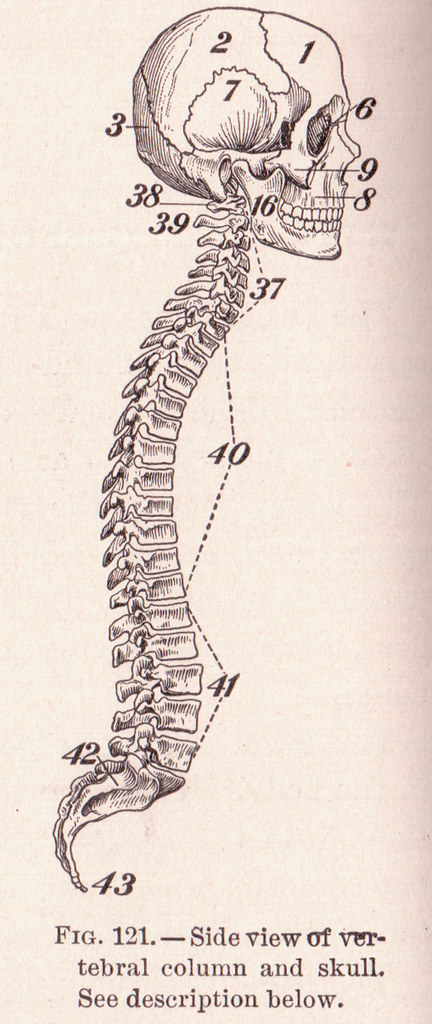Based on my recent articles, I’ve obviously been on a biological anthropology kick lately. This is partly due to plain ol’ curiosity. But I also find a strange comfort in it. Rather than viewing my back problems as an individual failure, I learned to view them as a consequence of weaknesses that evolved along with humans. The seeds of my destruction were planted millions of years before I was born.
Humans are part of the primate family tree, and we carry that inheritance in our genes. Once I understood how our ancestors and living primate cousins moved, and socialized, and gave birth, I realized how the particular failures of my body were a byproduct of our primate legacy and evolutionary trade-offs.
Many parts of our body frustrate us, because our imperfect adaptations predispose us to pain and injury. But perhaps no area of the body has been as poorly served as the spine. When we started walking upright, we took a structure that had been designed as a cantilever bridge (Krogman 1951), set it on end, and expected it to work just as well. Is it any wonder we have back pain?

Photo courtesy of Sue Clark via Flickr.
Two Contradictory Goals
If an engineer was tasked with designing a human spine, he’d be hard-pressed to design a structure that’s optimized for two diametrically opposed qualities: stability and flexibility. And yet, those are the two qualities our spines must provide.
In his book, Ultimate Back Fitness and Performance, Dr. Stuart McGill explained the challenge:
“[T]he spine is a stack of vertebrae that is called upon to bear loads, yet it is flexible. An engineer cannot design a structure to be good at both. A steel beam that is straight and stood on its end is stiff, and can bear loads that try to compress, shear and twist it. So the beam can bear load but it can’t move. In contrast, a flexible rod that allows movement will bend and buckle under load. Our spines must do it all (McGill 2017).”
The tradeoffs are evident, both in the fossil record, and in our own backs. The vertebrae of australopiths were long and thin, a shape which is not particularly well suited to absorbing the compressive forces. And increased compressive forces are an unavoidable feature of bipedal walking. Consequently, they appear to have suffered surprisingly high rates of spine injuries (Meyer and Williams 2019).
By the time Homo erectus arrived on the scene, hominin vertebrae had become shorter and wider, which helped to enhance stability, and allowed erectus to withstand the stresses of bipedal walking.
But wider vertebrae come with their own set of liabilities. They put more stress on the intervertebral discs, because the discs have to stretch and compress more to allow the same degree of movement. People with wider vertebrae are more prone to disc herniations, and do poorly with activities like gymnastics which require a great deal of flexibility (McGill 2016).
During a symposium, biological anthropologist Bruce Latimer explained how we managed this adaptation, and why it came with a curse. “We took the same amount of bone in our vertebra that a chimp has relative to its body size, and we then spread it out in a bigger vertebra, and it became less dense. And that means our vertebra are less strong than they are in chimpanzees (Boston University 2019).”
Most of the volume of our vertebrae is made up of spongy, trabecular bone. Trabecular bone is good at absorbing shock, because it can easily deform and spring back into shape. But the increased surface area also means that mineral loss happens more quickly, leaving us prone to osteoporosis and vertebral fractures.
Try to Be Flexible
Human spines have also undergone changes to enhance flexibility. In early members of genus Homo, the bony projections at the back of the neck vertebrae shortened. This gave the neck a greater range of motion, because the vertebrae weren’t always knocking into each other.
Chimpanzees and gorillas both have lumbar spines that are far more stable than humans’. They have fewer lumbar vertebrae, the lowest of which are trapped firmly between the twin blades of their pelvises.
To illustrate the difference between the rigid lumbar spines of great apes, and the flexible lumbar spines of humans, Latimer (during the same symposium) cut to a slide showing a yogini contorted in wheel pose. “No other mammal on the planet can do this!” he stressed. “If you don’t believe me, go home and take your cat. No, don’t do that. Don’t do that! I’m kidding. You would kill the thing. What you want to do is just to recognize that we can do that sort of thing. No other mammal can.”

Cats can’t figure out why humans want to do this.
Photo courtesy of Perzonseo Webbyra via Wikimedia Commons.
Of course, not everyone can achieve a graceful bridge. Due to both anatomical variation and disc degeneration, some people’s vertebrae will be crushed together during backbends. And many people with neural arch problems will find such a position painful. But the point remains – human spines have sacrificed some degree of stability for flexibility.
In order to balance this flexibility with stability, our bodies reached a careful compromise. We have a guy-wire system of muscles that stabilize the spine. Using muscles in this way means we can choose the amount of flexibility vs. stability we need for a given task. That is, assuming we have the muscular strength, endurance, and control required to do so.

Head to Tail Changes
You don’t even have to look at a human spine to realize that its structure and function is different from those of apes or monkeys. Our skulls contain the first clues. The foramen magnum, the opening which allows the spinal cord to pass into the neck, is positioned at the bottom of the skull, rather than at the back. This implies that our heads are designed to balance on top of our bodies.
Incidentally, the position of the foramen magnum, is one of the main clues scientists use to determine whether ancient apes were bipeds or quadrupeds. Since skulls fossilize more readily than vertebrae, it’s useful to have a way to make predictions based on the skull.
Since human heads are balanced on top of our spinal columns, we can get by with smaller neck muscles than other apes. They, like other quadrupeds, need to support their heads at the end of protruding necks.
The other end of the spine was subjected to its own modifications. Monkey have tails. Humans and apes do not. The shrunken remains of the tail can still be seen in the coccyx.
Perhaps it’s more accurate to say that the tail is not gone, just extensively modified. When apes lost their tails, they repurposed some of the muscles and the leftover vertebrae, and used them to support the pelvic floor. In humans, these structures are a useful way to support our internal organs during upright walking (Nakatsukasa 2019).
Reproduction’s Other “S”
Another key spinal modification was the S-shaped curve, which is present in humans and other extinct, bipedal hominins. This curvature serves two functions – it redistributes our weight to help us maintain balance, and it helps absorb the shock generated by walking on two feet. This curve was so critical that it appears in Australopithecus fossils from around 4 million years ago (Williams and Meyer 2019).
For reasons that have nothing to do with locomotion, the curve of the sacrum (the fused vertebrae between our lumbar spine and coccyx) is non-negotiable. If it was a straight rod, it would block the birth canal. Needless to say, natural selection would deal swiftly with this problem.
Reproductive needs affect the design of the lumbar spine as well. Towards the end of pregnancy, woman walk around with what is, mechanically speaking, a watermelon under their shirt. Their center of mass changes, and they’re forced to lean back to keep their balance. In late pregnancy, lumbar lordosis becomes more pronounced.
Both of these demands (pregnancy and childbirth) might explain why women show more pronounced lumbar curves than men do, at least on average. The architecture of lumbar vertebrae also differs slightly between the sexes. Women have comparatively larger facet joints, and bony processes that jut out at a different angle. Their vertebrae show greater wedging (Sparrey, et al. 2014).
Duct Tape and Paper Clips
As anthropologist Jeremy DeSilva noted, “Evolution works with duct tape and paper clips (Gibbons 2013).” Outside of a lab, organisms can’t be designed from scratch. Individuals can riff on a theme, but they inherit their basic body plan from their parents. There’s a design debt that organisms have to work around.
And even in the best cases, each trait involves trade-offs between competing demands. We can be flexible or stable, curvy or straight, thick-boned or thin-boned. And if we encounter forces that we weren’t optimized for? Well, someone has to be on the wrong side of evolution.
References
- Boston University. 2019. Boston University Dialogues in Biological Anthropology Number 6 – Part 1. April 2. Accessed January 6, 2021. https://www.youtube.com/watch?v=QKL061Rnk-I.
- Gibbons, Ann. 2013. “Human Evolution: Gain Came With Pain.” Science, February 16. Accessed January 5, 2021. https://www.sciencemag.org/news/2013/02/human-evolution-gain-came-pain.
- Krogman, Wilton M. 1951. “The Scars of Human Evolution.” Scientific American 185 (6): 54-57. https://www.scientificamerican.com/article/the-scars-of-human-evolution/.
- McGill, Stuart. 2016. Low Back Disorders: Evidence-Based Prevention and Rehabilitation. Third Edition. Human Kinetics.
- —. 2017. Ultimate Back Fitness and Performance: Sixth Edition. Gravenhurst, Ontario: Backfitpro Inc.
- Meyer, Marc R, and Scott A Williams. 2019. “The Spine of Early Pleistocene Homo.” In Spinal Evolution: Morphology, Function, and Pathology of the Spine in Hominoid Evolution, by Ella Been, Asier Gómez-Olivencia and Patricia Ann Kramer, 153-183. Springer. doi:10.1007/978-3-030-19349-2_8.
- Nakatsukasa, Masato. 2019. “Miocene Ape Spinal Morphology: The Evolution of Orthogrady.” In Spinal Evolution: Morphology, Function, and Pathology of the Spine in Hominoid Evolution, by Ella Been, Asier Gómez-Olivencia and Patricia Ann Kramer, 73*96. Springer. doi:10.1007/978-3-030-19349-2_5.
- Shapiro, Liza J., and Gabrielle A. Russo. 2019. “Vertebral Morphology in Hoinoids II: The Lumbar Spine.” In Spinal Evolution: Morphology, Function, and Pathology of the Spine in Hominoid Evolution, by Ella Been, Asier Gómez-Olivencia and Patricia Ann Kramer, 51-72. Springer.
- Sparrey, Carolyn J., Jeannie F. Bailey, Michael Safaee, Aaron J. Clark, Virginie Lafage, Frank Schwab, Justin S. Smith, and Christopher P. Ames. 2014. “Etiology of lumbar lordosis and its pathophysiology: a review of the evolution of lumbar lordosis, and the mechanics and biology of lumbar degeneration.” Journal of Neurosurgery 36 (5). doi:10.3171/2014.1.FOCUS13551.
- Williams, Scott A, and Marc R. Meyer. 2019. “The Spine of Australopithecus.” In Spinal Evolution: Morphology, Function, and Pathology of the Spine in Hominoid Evolution, by Ella Been, Asier Gómez-Olivencia and Patricia Ann Kramer, 125-151. Springer. doi:10.1007/978-3-030-19349-2_7.

2 thoughts on “The Human Spine is an Evolutionary Compromise”